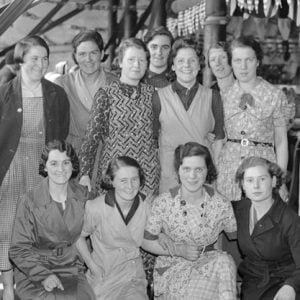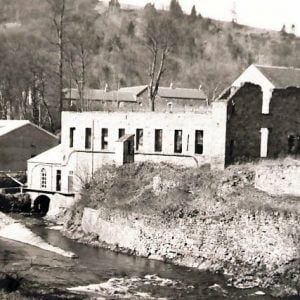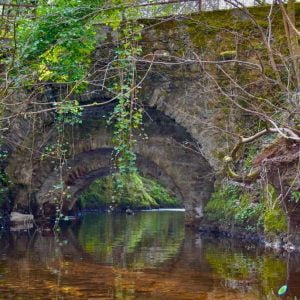
Summary
One of the most thriving and innovative centres in the history of Tayside's textile industry.
During the Industrial Revolution, Blairgowrie & Rattray was a bustling centre of the textile industry, first spinning flax, then jute and latterly rayon.
This itinerary, which will take you around 1.5 - 2 hours to walk, tells the story of eleven of the old Mills, how they worked, the innovations that were made in them and the challenges that the mill owners and their workers faced.
Scottish Outdoor Access Code: know the code before you go
You can download our booklet, From Deep Time To Our Time, Walking Across The Cateran Ecomuseum here.
You can also listen to an audio version of each of the Points of Interest, spoken by Meg Luckins, Chair of the Blairgowrie, Rattray & District Local History Trust.
Please use the arrows on left/right side to go to previous/next route
More information
You can read an introduction to A Spin Along the Ericht here and find out more about each point of interest below.
You can read the leaflet that accompanies this itinerary here and enjoy two short films below, one about the life and work of local master craftsman and weaver Ashleigh Slater below and one of the Trade Unionist Mary Brooksbank's famous 'Jute Mill Song' sung by Aileen Ogilvie.
You can enjoy a range of other general walks around Blairgowrie too, see here.
With thanks to Peter Dawson and Meg Luckins for their help in creating the content for this itinerary.
Route Stats
Total Distance: 5.6 km
Total Ascent: 50 m
Terrain: Mostly flat on paths and roads
Route Category: Straightforward
Walking Time: 1.5 - 2 hrs
Start/Finish: Wellmeadow/Brig ‘o’ Blair
OS Grid Ref: NO 18042 45224
Nearest Parking: At the start, further parking at various sites in town
Key Facilities on Route: Blairgowrie (shops, accommodation, EV chargers, restaurants, cafe)
OS Landranger Map: 53 (or custom Cateran Ecomuseum map)
For information on local accommodation & services click here
Please click on images to open slideshow, esc to close.
Photographs: Markus Stitz
Route Description
Start at the Brig ‘o’ Blair and take the riverside path on the eastern bank of the River Ericht and follow the path upstream, passing Plash Mill and the site of Muckle Mill. After a set of stairs you’ll join another path, from where you can see the unfinished lade, which was constructed to feed the waterwheels of the mills. You’ll also pass the viewpoint onto Cargill’s Leap. Soon Keithbank Mill, which overlooks the river on the opposite site, comes into sight, and at Oakbank Mill a bridge crosses the river. To see the sites of Ashbank Mill, Brooklinn Mill, the Arnbank Managers House, the Lornty Bridge and Lornty Mill, continue on the path up the river and return the same way. Cross the river on the bridge and walk up a set of steps, and turn left to follow Balmoral Road to see the sites of Bramblebank Works, Westfield Works and Craigmill, and return the same way. Keep following the road until a set of steps on the right takes you down to Riverside Road, and back to Brig ‘o’ Blair.
Find out more about some of the key Points of Interest below.
Points to visit
Along the way you will find these points of interest:

A Spin Along the Ericht
A thriving centre of innovation in Tayside’s textile history. The area around Blairgowrie & Rattray has evidence of human settlement that goes back to Neolithic times. The Romans reached here, there are remains of an important legionary...
Read more - "A Spin Along the Ericht"
The Brig ‘o’ Blair
A key river crossing to Highland Scotland. The Brig o’ Blair offers a fine view of the River Ericht, one of the Ecomuseum’s main rivers. Its rapid and often turbulent water course, which descends 80 metres (262.4ft) from its headwaters at...
Read more - "The Brig ‘o’ Blair"
Plash Mill
Flax into Linen. The textile industry in Blairgowrie began with the production of linen; jute was not processed until the middle of the 19th century. This Mill was used for the treatment of linen yarn, which was soaked in water and beaten by wooden...
Read more - "Plash Mill"
Muckle Mill & Ericht Linen
An industry takes hold. Just above the Brig ‘o’ Blair on the right bank of the Ericht stood the oldest spinning mill on the river. This was the Muckle (or Meikle) Mill. Erected in 1798 to spin linen, it seems to have been regarded as a very...
Read more - "Muckle Mill & Ericht Linen"
Unfinished Lade
Lost opportunity. A short distance from Oakbank Mill the Ericht rushes impetuously down a gorge, forming a cascade known as “The Keith.” Tradition points this out as the scene of “Cargill’s Leap”, where in 1679, Donald Cargill,...
Read more - "Unfinished Lade"
Oakbank Mill
A first for jute. This mill building is one of the few that remain standing of the group of flax and jute mills that run along each side of the River Ericht. Said to be the oldest of their type in Scotland, they are a classic example of a large...
Read more - "Oakbank Mill"
Keithbank Mill
Water and steam power. The original, small Keithbank Mill was built in 1830 by a Mr. William Fyfe, directly across the river from Oakbank Mill. In the late 1860s a new and larger mill was erected a ...
Read more - "Keithbank Mill"
Ashbank Mill
Mrs Baxter and Ashbank House. Ashbank Mill was built in about 1836 by a Mr. John Baxter. Originally it was used for spinning flax and tow (a coarse broken fibre removed during processing flax. The very light colour of flax tow is the...
Read more - "Ashbank Mill"
Bramblebank Works
Producing flax and tow with cutting edge machinery. Bramblebank was built in 1833 by Mr. David Rattray. It was driven originally by a condensing engine and by a turbine. In 1876 it employed 100 workers and produced flax and tow for Fife and the...
Read more - "Bramblebank Works"
Arnbank House & Tenement
Mill workers’ housing. Accommodation for mill workers became quite an issue as the 19thc progressed and the mills grew in number and size. The populations of Blairgowrie and Rattray grew considerably to 2,000 – 2,500 people but the mill...
Read more - "Arnbank House & Tenement"
Brooklinn Mill
Water powered turbines. Near the mouth of the Lornty Burn stands the site of Brooklinn Mill built in 1843 by Mr. David Grimond, son of the founder of Lornty Mill, now privately owned and offering self catering...
Read more - "Brooklinn Mill"
Westfield Works
Ravaged by fire. Westfield Mill was built in 1836 by a Mr John Milne on the site where once stood a lint mill occupied by a Mr Dollas, whence we get the familiar name given to this mill by ...
Read more - "Westfield Works"
Lornty Bridge
Triple layered bridge. This small single-arch random-rubble bridge built over the Lornty Burn lies on the line of former Military Road, but re-built to incorporate a concrete culvert on its west side in the 1990s. Until 1777 when the Brig o’ Blair...
Read more - "Lornty Bridge"
Lornty Mill
The smallest of all the mills. This mill stands about 300 yards up the Lornty Burn, a tributary of the River Ericht on the Blairgowrie side of the river. It seems to have been in size and production the smallest of all the mills which existed in...
Read more - "Lornty Mill"
Craigmill
The northernmost of all the mills of Blairgowrie and Rattray. The ruins of this mill, the northernmost of all mills in Blairgowrie and Rattray, stand about 500 yards below Craighall Bridge. It was built in 1834 by a Mr. George Saunders and was...
Read more - "Craigmill"
























